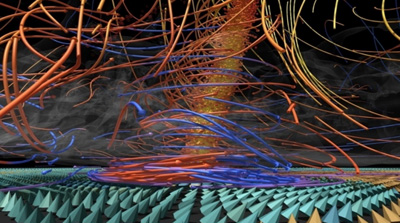SPECIAL FEATURE
Computing Research that Changed the World: Reflections and Perspectives
March 25, 2009 | 8:45 am - 5:00 pm | Members' Room, Thomas Jefferson Building, Library of Congress
Supercomputers and Supernetworks are Transforming Research
LARRY SMARR - UC, San Diego
![]() Slides - 1.5 MB
Slides - 1.5 MB
![]() Download - 258 MB
Download - 258 MB
![]() Watch the Talk (17:34)
Watch the Talk (17:34)
 Supercomputing has long been a "time machine," allowing us to first experience at the high end what will later become a ubiquitous consumer experience. The National Science Foundation (NSF) and other research agencies are the enablers of these time travels by investing in the innovative technologies that lead to new discoveries and new capabilities. The 1980's supercomputer is today's laptop, and yesteryear's research network is today's social networking infrastructure.
Supercomputing has long been a "time machine," allowing us to first experience at the high end what will later become a ubiquitous consumer experience. The National Science Foundation (NSF) and other research agencies are the enablers of these time travels by investing in the innovative technologies that lead to new discoveries and new capabilities. The 1980's supercomputer is today's laptop, and yesteryear's research network is today's social networking infrastructure.
As one integrating example, consider the NSFNet, a 56 kilobit/second (Kb/s) network funded by NSF to interconnect the NSF-funded supercomputing facilities across the United States. At the time, it was 50 times faster than the 1200 baud modems used for connection to university research facilities; today it is individual dial-up speed (except that few people use dial-up today)! The NSFNet was commercialized in 1995 and spawned the Internet we know today. In turn, the availability of a high bandwidth network and an internationally distributed group of computational science researchers spurred the development of collaboration tools at the National Center for Supercomputer Applications at the University of Illinois, including graphical telnet clients and the Mosaic web browser. In turn, Mosaic fostered the web revolution by people transfer to startup companies such as Netscape and licensing transfers to create Microsoft's Internet Explorer.
Supercomputer simulations not only necessitated high-speed networks for data transfer, they also created demand for visualizations to gain insights from the rising tide of data. By uniting artists and animators with scientific researchers in multidisciplinary teams, together with unprecedented computer rendering capability, modern scientific visualization and the stunning visual effects we now take for granted in movies and video games were born. Today, high-performance graphics hardware, algorithms and software illuminate our understanding of the evolution of the universe, the dynamics of weather and climate change, and the firing of neurons in the brain.
The personal computer, the Internet, and the World Wide Web, with their enormous social and economic impact, were all unexpected consequences of investments in long term, basic research. This interplay and the decade of gestation from idea to multibillion dollar industries typify the power and the value of curiosity-driven research. Equally importantly, they illustrate the importance of long-term commitments. The economic engines of the next decade are being developed by students and faculty in today's research laboratories.
What new opportunities lie ahead? Computing, visualization and communication advances continue. Petascale computing - a million times faster than 1980's supercomputers - is here, and researchers are actively exploring designs for exascale computing systems, another thousand times faster. Each order of magnitude increase in computing power allows us to model new phenomena, gain new insights and advance discovery, from understanding how our genetic blueprints are translated into biological behavior to designing low emission, renewal energy generation systems.
Truly ultrahigh bandwidth networks are near, with optical communication at speeds of one terabit/second or more, just as a new generation of petascale scientific models and scientific instruments produce hundreds of petabytes of computational and observational data, necessitating ever more powerful, high-resolution visualization and analysis tools. The cycle begins anew, with investments in high-performance computing, large-scale storage, high bandwidth networks and advanced visualization, coupled with a commitment to long-term, basic research, creating tomorrow's wonders.
It's all part of our enduring quest to understand - what, how, when and why - matter and the universe, life and its processes, and their importance to our lives, our society and our well-being.

